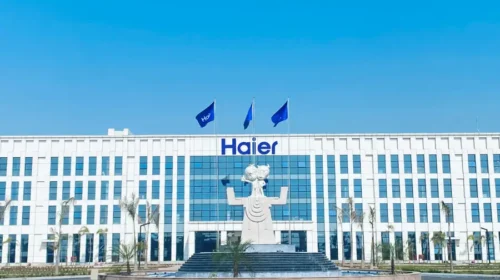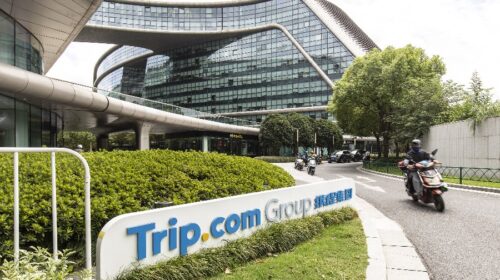CTG Duty Free delights shoppers with bargains, as its own costs run amok

Shares of China’s largest duty-free retailer have lost nearly half their value since late January as its profits sank, even after consumption rebounded in the first quarter
Key Takeaways:
- CTG Duty Free posted a record 20.77 billion yuan in first-quarter revenue, but its profit fell 10% during the period on faster-rising costs
- Analysts expect the company’s revenue to keep climbing, but cost control remains an important challenge
By Fai Pui
The five-day May 1 holiday, China’s first major break since lifting its Covid restrictions, saw a burst of travel nationwide, with tourist attractions and hotels packed to the gills. But the picture has been less rosy for China Tourism Group Duty Free Corp. Ltd. (CTG) (1880.HK; 601888.SH), whose own financial house is showing signs of disarray, even as tourists flock to its trademark duty free stores.
While other tourism tickers have jumped with the China’s travel recovery, CTG shares, which were listed in Hong Kong last August, have lost nearly half their value in the last three months, falling to HK$150 from a high of HK$280 on Jan. 27. Hardly a nice souvenir for stock buyers hoping to reap profits from China’s long-awaited travel recovery.
Many such stock pickers were probably hoping for good news from CTG’s first quarter results announced at the end of April. Instead, they were treated to the story of a company that couldn’t quite capitalize on the big rebound.
You can’t blame bargain hunters for CTG’s disappointment. The company’s revenue rose 23.8% year-on-year to a record 20.77 billion yuan ($3.10 billion) in the first quarter as offline shopping resumed. But the company’s gross margin dropped 5 percentage points to 29% on rising operating costs and selling expenses, leading to a 10.3% decline in its net profit to 2.3 billion yuan.
Unhappy at its inability to reap rewards from the travel rebound, shareholders dumped CTG’s stock after the results were announced, causing the stock to drop 11.5% in the next four trading days.
In need of cost controls
Like many of its traditional retailing peers, CTG Duty Free suffered heavily during the pandemic, as China strongly discouraged travel to contain Covid. As a result, its revenue and net profit fell 19.5% and 48% last year, respectively. But management sounded an optimistic tone when the company released its annual results in February, saying sales had rebounded significantly with the resumption of operations at its duty free stores. But investors clearly wanted more, as reflected by the sell-off for its shares.
“CTG’s first-quarter revenue growth of more than 20% was actually within market expectations, and the real concern lies in its cost control,” said Kenny Wen, KGI Asia’s head of investment strategy, commenting on the latest results. “The company’s costs grew faster than revenue last quarter, but management didn’t explain how it will effectively control costs going forward. Honestly speaking, I was bullish on the company this year. But its quarterly results disappointed me.”
Its latest results show CTG Duty Free’s operating costs rose 30% in the first quarter to 17.49 billion yuan, while its cost of sales jumped by 40% to 2.05 billion yuan. It attributed the big increases to this year’s lack of rent relief, which was a major cost-lowering benefit for the company when airports were closed or had limited operations last year. Its profitability also took a hit from heavier discounting this year to reduce its inventory, even as higher-margin products like jewelry and watches sold out.
A strong U.S. dollar also played a role, since CTG’s goods are mostly purchased with U.S. dollars. But its revenue is all Chinese yuan, leading to losses as the Chinese currency fell against the dollar in the first quarter.
Global luxury sales have been picking up recently, but agents like CTG are not benefiting much from the trend, said Dickie Wong, executive director of research at Kingston Securities. “However, the peak period of outbound travel during the May 1 holiday may help to improve CTG’s business performance in the second quarter,” he said. He added that several programs designed to help duty-free sales in the tourist-friendly Hainan province should help to accelerate the industry’s recovery, especially for sales of alcohol and luxury goods.
Leading broadcaster CCTV News, citing Hainan customs data, said the province recorded 350 million yuan in purchases since the implementation a month ago of one of the duty-free programs allowing people to immediately pick up merchandise after a purchase.
Lower price targets
Analysts were largely disappointed with CTG’s first-quarter results, with some even cutting their profit forecasts and target prices for the company. Citi said the company’s gross margin has been slow to recover post-pandemic, but it expects to see greater improvement in revenue and profit in the second quarter as promotions decrease and sales for its airport stores rebound. The bank maintained its “buy” rating on the company, but lowered its target price to HK$243 from HK$262.
Goldman Sachs also lowered its target price to HK$263 from HK$280 and reduced its profit forecasts for 2023-2025 by between 6% and 10%. It pointed out the big decline in CTG’s shares may reflect excessive pessimism among investors. But it maintained its own “buy” rating, noting that management is confident about the company’s future profit performance.
Ping An Securities said CTG is the leader in China’s duty free industry, with advantages in experience, scale and its supply chain. It forecast the company’s net profit will grow from 12.2 billion yuan this year to 16.4 billion yuan in 2024, and further rise to 20.8 billion yuan in 2025. That would drop its price-to-earnings (P/E) ratio from about 27 times this year to 16 times by 2025 as travel and tourism patterns return to pre-pandemic conditions over that time.
The company currently trades at a (P/E) ratio of about 55 times and a forward ratio of 26.7 times. That compares with a forward P/E ratio of 37 times for rival Hainan Haiqi Transportation Group (603069.SH), showing CTG Duty Free appears to be falling out of favor despite its market-leading status.
“Last year, the focus on the concept of consumption recovery led to high expectations for CTG Duty Free among investors, stimulating its share price. But now that the quarterly results have failed to meet expectations, its shares have fallen back to a more rational level,” said analyst Wen. He suggested investors may need to wait another one to two more quarters to see how much the company is benefitting from rebounding consumer demand, and also to see if it can bring its costs under control.
To subscribe to Bamboo Works weekly free newsletter, click here






